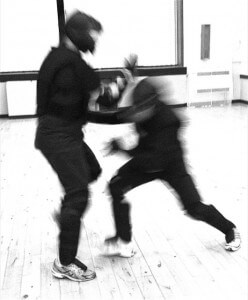In sports science, there is a vast and growing body of knowledge on the subject of Reaction Time, as it is one of the key components of the performance of skill.
Reaction Time is defined as the interval of time that elapses from the sudden presentation of a stimulus to the beginning of a person’s response. (Schmidt and Wrisberg 2008)
Reaction time (RT) is a good indicator of the speed and effectiveness of someone’s decision-making. Examples are the sprinter’s start in a 100m dash when they hear the start-gun, or a driver’s application of an emergency braking action in response to a red light.
RT delay occurs between stimulus presentation (such as a clenched fist or a drawn-back shoulder) and response initiation (such as a conscious deflecting action with the arm).
Performers who are able to minimise the RT Delay have a significant advantage in time-critical activities – a good example of a time-critical activity is in a conflict situation in which a service user physically assaults a staff member.
In many rapid skills, such as breaking away from an assault, success depends on how fast the performer can detect some feature of the environment, such as the opponent’s movement; decide what to do; and then initiate an effective countermove.
The Number of Stimulus-Response Alternatives influence Reaction Time and Decision Making (Schmidt and Wrisberg 2008)
Studies such as those by Brodie Paterson and Mark Dawes have highlighted the fact that many Breakaway training programmes attempt to teach “too many techniques within a relatively very short period of time, which could not allow the average practitioner time to become competent in their usage.”
In Paterson’s study, it was found that 21 techniques were taught within the ‘system’, including 6 different hair-pull defences, 4 different wrist-grab defences and 2 different lapel-grab defences. A training ‘system’ like this is a clear example of one which likely creates multiple Stimulus-Response Alternatives and thereby does not follow established sport-science evidence on reducing Reaction Time and improving Decision-Making for the staff.
In fact in the study undertaken by Rogers et al (2006), staff who were trained in breakaways were not easily able to recall the techniques in a clinical environment, under only moderate pressure and with some notice.
We suggest that by providing a large number of different Responses to similar Stimuli in the training sessions, the result of the training programme was ultimately interference with real-time, operational decision making!
The shortest Reaction Time is generally found where there is only one stimulus and one response; this is referred to as Simple RT. However as the number of possible stimulus-response (S-R) combinations increases, the time it takes a person to respond to any one of them (Choice RT) generally increases.
Multiple stimuli linked to multiple responses leads to longer Reaction Time, because the performer must first identify the stimulus and then choose the appropriate response.
We need to look at how performers can decrease the number of choices they have to deal with by having just a small number of Responses to focus on and how they may be able to rely on natural, in-built mechanisms to do so.
Our Self-Protection Trainer certification course incorporates much of this theory and provides examples of how to incorporate good practice into training design.
——————————————————————————–

Gerard O’Dea is a conflict management, personal safety and physical interventions training consultant. He is the training director for Dynamis, a specialist in personal safety and violence reduction initiatives and the European Adviser for ‘Verbal Defense and Influence’, a global programme which addresses the spectrum of human conflict. www.dynamis.training



Gerard,
This is an amazing post touching in a topic I’ve studied in-depth with various self-protection instructors.
Some years ago, I flew to the UK to be certified by Eddie Quinn who teaches his very effective “The Approach Self Protection Method.” The principles of this method of self-protection include his emphasis on addressing the “What technique?” syndrome. It speaks to what you highlight here, that is, reaction time is increased when too many options exist.
Burton Richardson (JKD, Silat, etc.) addresses this same principle with his emphasis on techniques which are “possible” (to successfully use), compared to techniques which are “probable” (to successfully use). One is then, according to him, most effective dispensing with the possibles, and focusing on developing a very small number of probables.
High-quality modern Combatives (e.g., Kelly McCann) emphasize this very same principle.
I like your post a lot. It implies that we can (and should) help our healthcare staff by training them in the smallest number of tactics and techniques which address the greatest number of situations, thus heling them to generate the fastest responses to threatening scenarios.
Thank you again.
robert